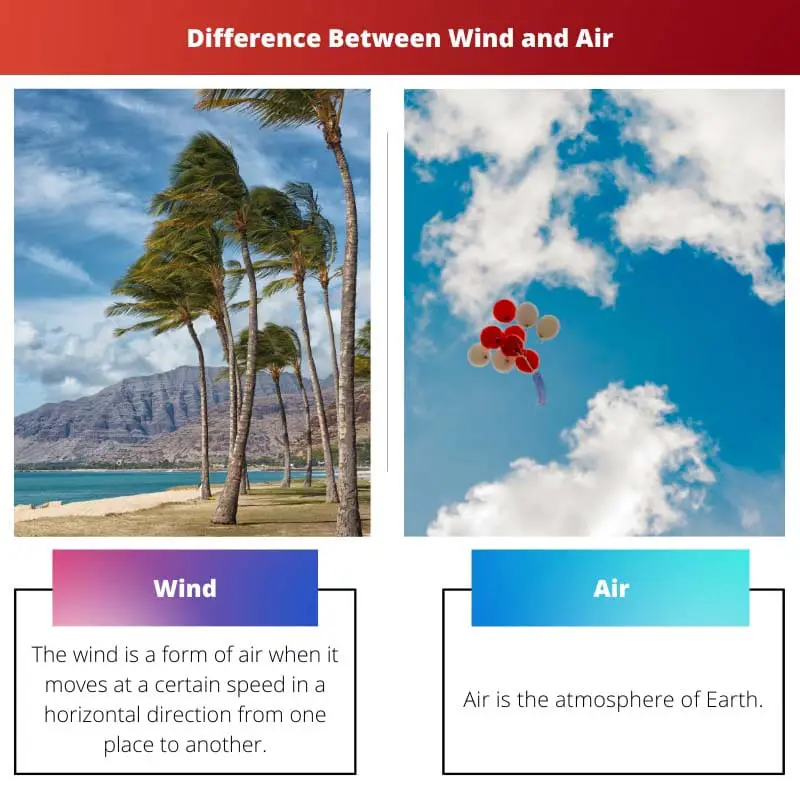Life is possible on Earth, and in fact, the Earth is the only planet where life is possible. However, the human body needs certain resources, such as air, water, and food, to sustain life.
Though a person can survive for a couple of days without food or water, it is impossible in the case of air. A person can merely survive a couple of minutes without air.
Thus, the air is a crucial component when it comes to sustaining life. However, the wind is also a type of air only. Though they are similar, wind and air have several different dissimilarities.
Key Takeaways
- The wind is the movement of air, while air is a mixture of gases that make up Earth’s atmosphere.
- Differences in air pressure and temperature generate wind, while air provides the medium through which wind travels.
- “Wind” and “air” are crucial in weather, climate, and sustaining life on Earth.
Wind vs Air
The uneven heating of the earth by the sun and the rotation of the earth produce wind, which is the movement of air. Breezes to natural disasters such as hurricanes and tornadoes are all kinds of winds. The gas combination that makes up the Earth’s atmosphere and that all living terrestrials breathe is called air.

Wind can be called a moving form of air. Another word for wind is air currents. That is to say, when air flows from one region to another, majorly due to the movement of the Earth and the difference in pressure among regions, it is then known as wind.
The component of the atmosphere is known as Air. In other words, it can be said that the air forms the atmosphere of the Earth. The air majorly consists of gases, dust particles, and water vapour.
Air plays a major role in the transmission of electromagnetic waves and sound waves as well.
Comparison Table
| Parameters of comparison | Wind | Air |
|---|---|---|
| Meaning | The wind is a form of air when it moves at a certain speed in a horizontal direction from one place to another. | Air is the atmosphere of Earth. |
| Occurrence | Wind majorly occurs in the stratosphere, which is a layer of atmosphere closest to the surface. | Air is present in all 5 layers of the atmosphere of Earth. |
| Existence | The wind is moving. | Air is constant. |
| Kinetic energy | The wind has more kinetic energy as compared to air. | Air has less kinetic energy as compared to wind. |
| Dust content | Wind consists of more dust particles as compared to the dust content in the air. | Air has fewer dust particles as compared to the dust content in wind. |
What is Wind?
The word ‘wind’ is derived from a Latin word called ‘Ventus’. The major component of wind is gas. Just like air, wind also contains several different gases.
One of the major characteristics of gases is that they travel from a region of high pressure to a region of low pressure.
When Earth rotates and revolves around the Sun and the gravitational force of the moon also has a major effect on the atmosphere of the Earth. All these factors result in the creation of pressure in the atmosphere of Earth.
Due to the movement of Earth around the Sun, some regions on Earth face high pressure, while some of them face low pressure. The pressure keeps changing constantly as the earth keeps on rotating and revolving.
Due to the creation of high-pressure regions and low-pressure regions on the earth, the gases present in the atmosphere of the planet tend to be moved as per their characteristic.
So, the air present in Earth’s high-pressure regions starts to move to low-pressure regions. As a result, air currents are created, which are known as winds.

What is Air?
The atmosphere of Earth is divided into 5 different layers, that are, troposphere, stratosphere, mesosphere, thermosphere, and exosphere. All these 5 different layers consist of air, however, the composition of air might vary depending upon the layer.
Irrespective of the layer of the atmosphere, the major component of air gases. The most abundant gas that is present in the air is nitrogen, which makes up about 78% of the total composition of the air.
Other components of air are oxygen which is equal to 21%, and carbon dioxide is equal to about 0.04%, argon is equal to 0.93%, and other gases, which are present in minor amounts.
The major concentration of oxygen, also known as life gas, is in the stratosphere, which is also the closest layer to Earth. It is one of the reasons why life exists on Earth.
When a person goes higher in altitude, the concentration of oxygen reduces. As a result, the availability of oxygen reduces as well. That is the reason why mountaineers wear oxygen masks while climbing up the mountains.

Main Differences Between Wind and Air
- The wind has more speed as compared to the air. On the other hand, the air is constant or very less speed.
- The wind has more strength as compared to air. On the contrary, the air has less strength as compared to the wind.
- The wind has a direction, that is to say, wind flows from one place to another. Whereas, the air has no direction.
- Wind can be converted into different types of energy, such as electrical energy. On the other hand, air cannot be converted into any energy.
- Wind can be of several different types, such as breeze, tornado, hurricane, storm, and more. Whereas, the air has no such types.

